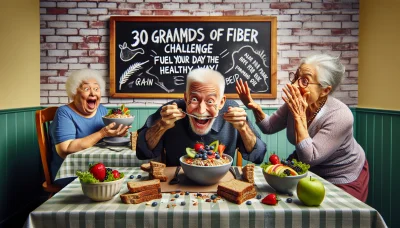Leangains protein Quiz
Test Your Knowledge
Question of
Understanding Leangains Protein Principles
The Role of Protein in Leangains
Protein is the cornerstone of the Leangains protocol, serving as the fuel for muscle growth and maintenance. Its high thermogenic effect boosts metabolism, making it a critical component for anyone looking to transform their physique.
Muscle Growth and Repair: Consuming adequate protein is non-negotiable in Leangains. It provides essential amino acids that act as building blocks for muscle repair post-workout, driving growth and enhancing recovery.
Satiety and Hunger Management: The satiating power of protein cannot be overstated. It keeps you full longer, helping to manage hunger and reduce overall calorie intake without feeling deprived.
Metabolic Advantages: The body uses more energy to digest protein compared to fats or carbs. This metabolic edge means higher calorie burn even at rest, which is key for fat loss and lean muscle preservation.
Calculating Your Protein Needs
Finding your optimal protein intake is critical for leveraging the benefits of Leangains. It's not one-size-fits-all; your needs are unique based on several personal factors.
Determining Lean Body Mass: Understanding your lean body mass is the first step to calculating protein needs. A higher lean mass means increased protein requirements to support and build muscle tissue.
Activity Level Considerations: Your activity level directly impacts your protein needs. More active individuals or those with strenuous workout routines will require more protein to fuel recovery and adaptation.
- Evaluate Regularly: As your weight changes or training intensity varies, so too should your protein intake. Regular evaluation ensures you're meeting your body's current demands.
- Listen to Your Body: Pay attention to how your body responds to different levels of protein intake. Recovery speed, hunger levels, and overall performance are good indicators if adjustments are needed.
- Vary Your Sources: Incorporate a variety of protein sources to benefit from different amino acid profiles and nutrients essential for overall health.
- Mind the Timing: Strategically time your protein consumption around workouts to maximize muscle protein synthesis and recovery.
- Adjustments for Weight Goals: If you're aiming to lose fat, a higher protein intake can help preserve lean mass. Conversely, if bulking up is the goal, ensure sufficient protein to support new muscle growth.
Implementing Leangains in Your Diet
Structuring Your Meal Plan
Leangains is a game-changer for fitness enthusiasts, and it starts with a solid meal plan. It revolves around the concept of intermittent fasting which fuels fat loss and muscle gain. By crafting a meal schedule that aligns with your workout routine, you optimize nutrient intake when your body needs it the most.
Intermittent Fasting Schedule: The core of Leangains is an 8-hour eating window followed by a 16-hour fast. This cycle not only simplifies dieting but also sharpens mental clarity and boosts metabolic rate. Its crucial to stay consistent with the timing to reap the full benefits.
Pre- and Post-Workout Nutrition: Nourishing your body before and after exercise is critical. A pre-workout meal should be rich in protein and complex carbs for sustained energy, while post-workout meals need protein for muscle repair and carbs to replenish glycogen stores.
Meal Timing and Frequency: Within the 8-hour window, aim for three meals. This frequency ensures a steady supply of nutrients without overwhelming digestion. The largest meal should ideally be post-workout when insulin sensitivity is at its peak.
Choosing the Right Protein Sources
Selecting high-quality proteins is pivotal for muscle synthesis and overall health. Proteins are not created equal, so understanding their sources and characteristics can significantly impact your Leangains journey.
Animal vs. Plant-Based Proteins: Animal proteins provide all essential amino acids making them complete sources. However, plant-based proteins can also play a role in a balanced diet, especially when combined correctly to form complete proteins.
Complete vs. Incomplete Proteins: Complete proteins contain all nine essential amino acids necessary for bodily functions. Incomplete proteins lack one or more of these amino acids but can be paired with other foods to create a complete amino acid profile.
- Protein Quality and Bioavailability:
- Opt for lean meats like chicken or turkey for high-quality protein with less saturated fat.
- Fish, particularly fatty fish like salmon, provide omega-3 fatty acids alongside high-quality protein.
- Eggs are among the most bioavailable sources of protein, ideal for muscle repair and growth.
- Incorporate a variety of plant-based proteins such as lentils, beans, tofu, and quinoa to cover all essential amino acids.
- Dairy products like Greek yogurt and cottage cheese offer excellent protein content with added calcium benefits.
- Nuts and seeds are great snack options providing both healthy fats and protein.
- Avoid processed meats as they may contain additives that arent aligned with health goals.
- Mixing plant proteins like rice and beans can form a complete protein source for vegetarians and vegans.
Overcoming Common Leangains Challenges
Dealing with Hunger and Cravings
Hunger and cravings can be significant hurdles in the Leangains journey, but they're not insurmountable. Recognizing that hunger is often a temporary sensation can empower you to push through the discomfort. Planning your meals and ensuring you have healthy snacks on hand can also prevent impulsive eating decisions driven by cravings.
Emotional eating is a common pitfall. It's essential to distinguish between true hunger and eating out of boredom, stress, or other emotions. Creating a routine that includes regular meal times can help stabilize your hunger patterns, making it easier to stick to the Leangains protocol.
Strategies for Managing Appetite
A high-protein diet is a cornerstone of the Leangains approach and plays a critical role in managing appetite. Protein-rich foods provide satiety and help maintain muscle mass, which is vital during weight loss. Incorporating fiber-filled vegetables and fruits also contributes to a feeling of fullness without adding too many calories.
Strategic use of caffeine can be another tool for appetite suppression. A moderate intake of coffee or tea may reduce hunger pangs. However, it's crucial not to overdo it as excessive caffeine can lead to increased anxiety and disrupt sleep patterns.
Hydration and Its Role in Satiety
Staying well-hydrated is an often overlooked aspect of dieting that can significantly impact hunger levels. Drinking water before meals has been shown to increase feelings of fullness, leading to reduced calorie intake. Sometimes, what we perceive as hunger is actually thirst, so reaching for a glass of water before snacking can be an effective strategy.
Including water-rich foods like soups, salads, and certain fruits can contribute to hydration while providing valuable nutrients. Such foods have the added benefit of being low in calories yet high in volume, helping you feel satisfied with fewer calories.
Mindful Eating Practices
- Eat slowly and without distractions to better recognize your bodys satiety signals.
- Focus on the flavors, textures, and aromas of your food; this mindfulness aspect can enhance the dining experience and promote satisfaction with smaller portions.
- Avoid 'autopilot eating' by routinely checking in with your hunger levels before and during meals.
- Implement a regular eating schedule to train your body's hunger cues and avoid unnecessary snacking.
- Practice portion control by using smaller plates or bowls to prevent overeating.
Staying Consistent with Your Diet
Consistency is key in any diet plan, including Leangains. One way to stay consistent is by setting realistic goals that align with your lifestyle. Establishing clear objectives provides direction and motivates you to adhere to your dietary regimen.
Preparing meals ahead of time ensures that you always have access to appropriate food choices, reducing the likelihood of deviating from your plan. This preparation also simplifies decision-making throughout the week when time might be scarce.
Tracking Progress Effectively
Tracking progress goes beyond stepping on a scale; it involves monitoring various metrics such as body measurements, strength gains, energy levels, and overall well-being. This comprehensive approach provides a more accurate picture of your progress and keeps you motivated.
Utilize apps or journals for logging food intake and exercise routines; these records are invaluable for identifying patterns that either contribute to or detract from your success. They serve as a tangible reminder of how far youve come and what adjustments might be needed moving forward.
Coping with Social Events and Dining Out
Social events don't have to derail your diet. With some foresight, you can navigate dining out while maintaining your Leangains regimen. Researching restaurant menus ahead of time allows you to select options that fit within your dietary constraints.
You don't have to miss out on social opportunities because of dietary restrictionscommunicate your needs clearly when necessary or suggest venues that offer suitable choices.
Adapting Leangains to Lifestyle Changes
Lifestyle changes don't have to spell disaster for your Leangains goals. Being adaptable means modifying your eating window or workout schedule as needed without completely abandoning the principles that make Leangains effective.
Finding balance is crucial; life will throw curveballs at you, but with flexibility built into your approach, those changes become manageable rather than catastrophic.
Remember: consistency over perfection! Small deviations won't ruin progress if they're handled thoughtfully.
Complementing Leangains with Other Dietary Approaches
Integrating Leangains with Keto
Merging the Leangains protocol with a ketogenic diet can turbocharge your fitness goals! By maintaining a state of ketosis, you incinerate fat while fasting and feasting on a high-fat, low-carb diet. This combination could be your ticket to rapid body composition changes.
Keto-adaptation melds perfectly with the 16/8 fasting window of Leangains. Your body learns to switch fuel sources seamlessly, using fats for energy during fasting periods and preserving muscle mass all thanks to the strategic eating schedule of Leangains.
Balancing Macronutrients
Striking the right balance of macronutrients is crucial when combining Keto with Leangains. Prioritize healthy fats and moderate protein intake while keeping carbs exceptionally low to stay in ketosis. Adjust your macros to align with workout intensity for optimal results.
Ensuring Adequate Fiber Intake
Don't let your fiber intake fall by the wayside! It's essential for digestive health, especially on Keto. Focus on fibrous veggies within your carb limit to keep things moving smoothly. Remember, a happy gut is a cornerstone of overall wellness.
Managing Ketosis with Intermittent Fasting
Intermittent fasting with Leangains can accelerate entering ketosis, making it an effective strategy for those following a ketogenic diet. It's like hitting the fast-forward button on reaching your body composition goals just make sure to monitor your ketone levels regularly!
Combining Leangains with a Plant-Based Diet
Diving into a plant-based diet while practicing Leangains? Absolutely possible! This dynamic duo can lead to impressive health benefits and muscle gains. The key lies in choosing high-quality plant proteins and being mindful of nutrient timing.
The synergy between intermittent fasting and plant-based eating could be groundbreaking for your health journey. It's all about intentional food choices within your eating window that support both muscle growth and overall vitality.
Finding Plant-Based Protein Options
- Lentils and beans are not only protein-packed but also rich in fiber, making them a staple in any plant-based athlete's diet.
- Quinoa and buckwheat offer complete protein profiles while adding variety to your meals.
- Nuts and seeds, along with their butters, are an excellent source of healthy fats and proteins perfect for snacking or meal enhancement.
- Tofu and tempeh stand out as versatile protein sources that can be marinated, grilled, or sauted to perfection.
- Pea protein powders provide that extra boost for post-workout recovery without any animal products involved.
Meeting Nutritional Requirements
Navigating nutritional requirements on a plant-based Leangains approach requires attention to detail. Ensure you're getting enough iron, B12, omega-3s, and calcium through fortified foods or supplements if necessary. A well-rounded approach is instrumental in thriving on this diet combo.
Planning Balanced Vegan Meals
Crafting balanced vegan meals that complement the Leangains method is an art form. Emphasize diversity in your food choices to cover all micronutrient bases. Don't forget to include healthy fats like avocados and olive oil to support hormone function and satiety!
Optimizing Workout Performance on Leangains
Pre-Workout Nutrition Strategies
Fueling your body before a workout is crucial for maximizing performance, especially on a Leangains regimen. It's all about the right nutrients at the right time. Ensuring you consume a balanced meal with an adequate amount of protein can set the stage for muscle priming and energy supply.
Timing Protein Intake for Muscle Priming : Consuming protein about 30 to 60 minutes before training can significantly enhance muscle synthesis. This pre-workout protein boost can lead to increased strength and endurance gains from your session.
Carbohydrates and Performance Enhancement : Don't overlook carbs! They're your muscles' best friend when it comes to high-intensity workouts. A moderate intake of low-glycemic carbohydrates before hitting the gym can provide sustained energy and prevent premature fatigue.
Hydration and Electrolyte Balance : Hydrate, hydrate, hydrate! Water is key, but don't forget electrolytes like sodium and potassium, which support nerve function and muscle contractions. An electrolyte-rich drink can be a game-changer for your performance.
Post-Workout Recovery Techniques
After pushing your limits during a workout, it's time to shift focus to recovery. This phase is as important as the training itself because it's when your body repairs and strengthens itself.
Protein Timing for Optimal Recovery : Immediately after your workout, within the golden hour, get that protein in! This will kickstart the repair process, aiding in quicker recovery and growth.
The Role of Carbs and Fats in Muscle Repair: While protein might steal the spotlight, don't neglect carbs and fats post-workout. Carbohydrates replenish glycogen stores, while fats can help manage inflammation. A balanced meal post-exercise supports overall recovery.
- Maintain Consistency: Regularly consume well-balanced meals post-workout to optimize recovery.
- Stay Hydrated: Continue drinking water after exercising to replace fluids lost through sweat.
- Sleep Quality: Prioritize good sleep as it's a cornerstone of muscle repair and overall wellness.
- Active Rest: Engage in light activities on rest days to promote circulation and healing.
- Variety in Diet: Ensure you're getting a variety of nutrients by including different food sources in your meals.
- Avoid Overtraining: Listen to your body and avoid pushing too hard if you haven't fully recovered.
- Mental Health: Stress management techniques can further enhance physical recovery.
Importance of Sleep and Rest Days: Never underestimate the power of sleep and rest days. They are essential components of an effective fitness program, allowing for full recovery and growth. Prioritize them just as you would any aspect of your training or nutrition plan.
Advanced Tips for Maximizing Leangains Results
Fine-Tuning Macronutrient Ratios
When it comes to Leangains, macronutrient ratios are your secret weapon. It's not just about counting calories; it's about making those calories work for you. Tailoring your intake of carbs, fats, and proteins can rev up your metabolism and catapult your body into a fat-burning, muscle-building machine. Don't settle for generic ratios; customize them to fit your body's response and activity level.
Adjusting Protein Intake Based on Results is a game-changer. Protein is the cornerstone of muscle repair and growth. If you're not seeing the gains you expect, bump up your protein intake. Conversely, if you're gaining unwanted fat, dial it back a smidge. It's all about staying in tune with your body's signals and responding accordingly.
Balancing Fats and Carbs for Energy Levels can be tricky but oh-so-rewarding. Low energy can sabotage your workouts and recovery, so listen to your body. Some thrive on higher carbs, while others may need more fats. Experiment and find that sweet spot where you feel strong and energized.
Periodic Reassessment of Dietary Needs is crucial as your body changes, so do its nutritional requirements. Every few months, take stock of where you're at physically and adjust those macros! It might just be the tweak needed to push past plateaus.
Incorporating Supplements Effectively
Dive into the world of supplements with a strategic mindset; they are potent allies when used wisely in the Leangains protocol. Your primary focus should be enhancing muscle gain and speeding up recovery, but don't let yourself get overwhelmed by the plethora of options out there.
Selecting Supplements for Muscle Gain and Recovery requires a discerning eye. Creatine monohydrate and branched-chain amino acids (BCAAs) have solid reputations for good reasonthey work. But remember, they're supplements, not magic potions; they support a solid diet.
- Avoid loading up on every supplement under the sunstick to what works.
- Research each supplement thoroughly before adding it to your routine.
- Monitor how each supplement affects you individuallywhat works for one might not work for another.
- Consider timingsome supplements are most effective pre- or post-workout.
- Always prioritize whole food nutrition over supplementation.
- Maintain proper hydration when taking supplements to aid absorption and efficacy.
Understanding the Role of Vitamins and Minerals in a Leangains approach is often underrated but vitally important. Micronutrients support everything from energy production to hormone balancedon't neglect them! A well-rounded multivitamin can fill any gaps left by diet alone.
Evaluating the Need for Protein Powders and Amino Acids : While whole foods should always come first, protein powders can be an efficient way to meet high protein requirements without excess calories or prep time. Amino acids, particularly BCAAs, can be especially useful around training sessions to fuel muscles directly when they need it most.












